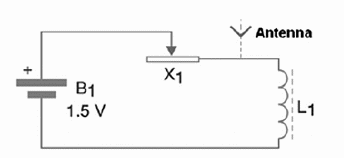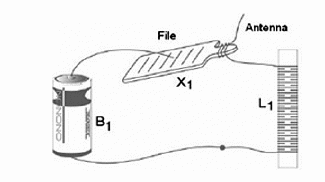This possibility can be explored in science fairs, demonstrations or as a scholar work. The radio signals can pass through obstacles like walls, wood or brick barriers, and be picked up by small portable transistor radios.
Experimentally the builder can demonstrate these outcomes, but the project can also be used as an experimental transmitter for communications.
Operation Principle
Short interruptions of a current flow can generate electric charge oscillations. An oscillating electric charge produces high frequency electromagnetic waves, which can propagate through space with the speed of light.
We can produce those vibrations simply by scraping a wire connected to a cell to a file. As an inductive load, in order to reinforce the oscillations we add to this simple circuit a coil with a ferrite core. In fact, this circuit does not produce radio oscillations of a fixed frequency.
The signal spreads through a large spectrum of frequencies, but some of the components fall in the medium and short wave band, and that is what allows the use of common transistor radios to its reception. The signal can be considered an electromagnetic noise or electromagnetic interference (EMI) that does not allow its operation in a common communications system, since it produces interference in any receiver placed in its range.
Circuits like this were experimented on by many researchers in the earlier days of the radio, like Marconi, Landel de Moura, Popov, and others pioneers. In our system, we use a length of wire of about 50 cm as antenna, enough for short range transmissions needed to demonstrations purposes.
Even without the antenna, the signals can be tuned to radios placed up to some meters. Of course, this is a device only recommended for demonstrations, like most part of the ones described in this book. Figure 1 shows the schematics diagram for this radio transmitter.

Since no parts are soldered, the circuit does not need a printed circuit boardor a terminal strip to be asembled. The placement of the components for this transmitter is shown in Fig. 2.

Any common file can be used to produce the rapid cuts in the current flow through the circuit.
The coil is formed using about 40 turns of any wire (18 to 32 AWG) on a ferrite core with a diameter of about 1 cm (0.4 in) and a length of 10 to 25 cm (4 to 10 in.). The ferrite core can be scavenged from any old nonfunctioning transistor radio.
The connections to the cell and file are made using the coil’s own wires, and the enamel cover must be removed to allow proper electrical contact.
The operation of the transmitter is very simple. Place the transmitter near an AM transistor radio tuned to a random point on the dial. When scraping the wire against the file, a noise will be reproduced by the transistor radio. The reader will discover that the signals can pass through such obstacles as walls and wood panels.
The signals can be coded in Morse code, thus allowing telegraphic messages to be sent and received. The sender can use a long rasp to indicate a dash and a short rasp for a dot. By associating dashes and dots, it is possible to send complete messages.
This will demonstrate how a primitive telegraph station operates. (See other telegraph projects in this section for more information.)
You can extend the transmitters range by using a larger antenna. A wire 2 to 5 m (6.5 to 16.5 ft) long and a connection to ground can offer ranges up to 10 m. As explained previ- ously, because this transmitter is not tuned, it can produce severe interference in any communication receiver placed within its range.
TVs and AM and FM radios can be affected by its signals. In addition, shortwave radios tuned in the range of 3 to 20 MHz can pick up the signals.
Important note: when not using the transmitter, do not leave the wire in contact with the file.
This will cause a high current drain that can run down the cell in a very short time.
Competitions
Award a prize for the transmitter that reaches the greatest distance with its signals.
Make a contest using telegraph transmissions as described in other telegraph projects in this site.
Bi-C or D cell
Ki-One file (any type)
L1-Coil with ferrite core (see text)
Other Components
Enameled wire, wires, solder (to connect the wires to the
cell), AM radio receiver, etc.



